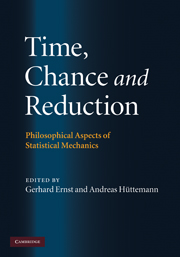Book contents
3 - The past hypothesis meets gravity
from Part I - The arrows of time
Published online by Cambridge University Press: 04 August 2010
Summary
Introduction
Why does the universe have a thermodynamic arrow of time? The standard reasoning relies on the truism: no asymmetry in, no asymmetry out. If the fundamental laws of Nature are time symmetric invariant (that is, time reversal), then the origin of the thermodynamic asymmetry in time must lie in temporally asymmetric boundary conditions. However, this conclusion can follow even if the fundamental laws are not time reversal invariant. The more basic question is whether the fundamental laws – whether time symmetric or not – entail the existence of a thermodynamic arrow. If not, then the answer must lie in temporally asymmetric boundary conditions. No asymmetry of the right kind in, no asymmetry out. As it happens, as I understand them, none of the current candidates for fundamental law of Nature entail the thermodynamic arrow. String theory, canonical quantum gravity, quantum field theory, general relativity, and more all admit solutions lacking a thermodynamic arrow. So a first pass at an answer to our initial question is: the universe has a thermodynamic arrow due in part to its temporally asymmetric boundary conditions.
Merely locating the answer in boundary conditions, however, is not to say much. All it does is rule out thermodynamic phenomena being understood as a corollary of the fundamental laws. But that's true of almost all phenomena. Few events or regularities can be explained directly via the fundamental laws. If we are to have a satisfying explanation, we need to get much more specific.
- Type
- Chapter
- Information
- Time, Chance, and ReductionPhilosophical Aspects of Statistical Mechanics, pp. 34 - 58Publisher: Cambridge University PressPrint publication year: 2010
References
- 9
- Cited by

